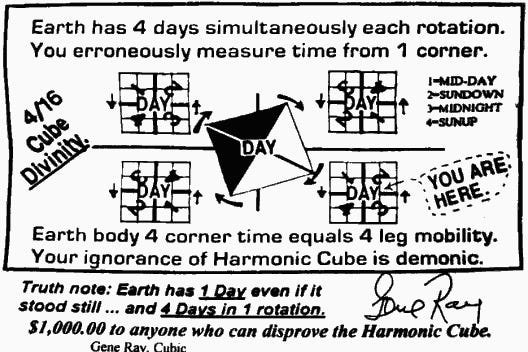Decibels Are Ridiculous

I don’t have many pet peeves. That said, no matter how hard I try, I just can’t get over the sheer madness of the scientific “unit” we call the decibel (dB).
What’s a decibel? Well, the most common answer is “uhh". The second most common answer is that it’s “a way to measure loudness”. But it isn’t! A decibel is not a unit in any conventional sense: it’s more akin to a prefix such as mega- in megabyte. It describes a change in magnitude.
On the face of it, the idea makes sense. We sometimes want to say that some quantity has increased 10× or 1,000× — and in engineering, these numbers can get large. In principle, we have several types of shorthand notations; for example, instead of “300,000” we can write “3e5”. That said, I don’t know how to pronounce “3e5”, so it’s not unreasonable to come up with a name for the exponent. “An increase of five clerts” could mean that something has grown by a factor of 105.
This brings us to a pseudo-unit called the bel. At first blush, it works just like our clert: it’s specifies the exponent of a 10n multiplier. In other words, +1 bel is a 10× increase (10+1); meanwhile, -2 bels means a decrease of 100× (10-2). The bel is named in the honor of Alexander Bell; this is in the same tradition that prompted us to name the “wat” in honor of James Watt.
But wait, there’s a twist! The bel was originally devised for measuring power. In some cases, the dissipated power has a quadratic relationship to the applied voltage; for example, for resistive loads in electronics, we have Joule’s law:\(P = V^2R\)
In this scenario, if the applied voltage increases by a factor of x1, the consumed power increases by a factor x2. More generally, if voltage applied to a resistor increases n clerts, then power dissipation jumps up 2n clerts. This is because (xn)2 = x2n.
Seeing this, some madman decided that 1 bel should always describe a 10× increase in power, even if it’s applied to another base unit. This means that if you’re talking about watts, +1 bel is an increase of 10×; but if you’re talking about volts, it’s an increase of √10×. This is nuts: it’s akin to saying that the milli- prefix should have different meanings depending on whether we’re talking about meters or liters. And what if you want to express other units on a similar scale — is frequency more like power or more like voltage?
The weirdness didn’t end there. For some reason, the bel — again, what started as a sensible 10× increment — was soon deemed too big to use. I don’t quite know why: in other aspects of life, decimal notation suits us just fine. Either way, instead of putting up with the occasional fractional value or switching to base 2, we divided the bel into ten steps known as decibels. In effect, we started raising 10 to a fractional power, producing irrational per-dB multipliers:\(\begin{align} \text{For power: } & 10^\frac{1}{10} \approx 1.258925 \\ \text{For voltage: } & \sqrt{10}^{\ \frac{1}{10}} = 10^{\frac{1}{2} \cdot \frac{1}{10}} = 10^\frac{1}{20} \approx 1.122018 \\ \end{align}\)
The original unit is long-forgotten; we use decibels exclusively.
What didn’t change from bels to decibels is that the concept describes nothing more than an exponent for a multiplier; the value is meaningless unless we know the base unit and the reference point (e.g., 1 V). As a matter of custom, however, both of these are often underspecified; in many fields, the decibel evolved into a standalone unit — or a collection thereof. This makes the decibel an “if you know, you know” kind of a deal.
For example, in acoustics, the “dB” unit actually corresponds to air pressure in pascals (quick quiz: is that a power-like or a voltage-like quantity?). As for the meaning of 0 dB, the measurement is usually indexed to a 1 kHz sound wave that exerts 20 μPa of pressure. This makes some sense: it’s roughly the threshold of human hearing. That said, no part of the “dB” label tells you that.
From this 0 dB origin, we derive two parallel acoustic scales. One measures the absolute sound pressure level with no regard to frequency; another is weighted to mimic human hearing. The latter peaks at 3 kHz, then tapers off sharply below 200 Hz and above 10 kHz.
Now, let’s imagine you’re trying to buy a microphone; the spec will give you a sensitivity figure such as -45 dB. Is that one of the two acoustic decibels? Fat chance! Here, the real unit is volts. The zero point on that scale describes a hypothetical microphone that produces a 1 V swing in response to a reference sound level. If the microphone you’re looking at is specified at -45 dB, it means that the measured swing is 1 V · 10-45/20, or about 6 mV.
But hold on: what’s that reference sound level? “Oh, I know,” you exclaim, “it’s the threshold of human hearing”. Nope! It’s 94 dB, roughly the loudness of a gas-powered lawnmower. We can play that game for a long time.
Even in situations where a decibel “unit” has a suffix to hint at what it describes, the naming schemes make little sense. For example, in radio applications, you can come across “dBm”. Is that decibel-meters? No, that would be silly: it’s a measurement of power relative to 1 milliwatt. So, it must follow that “dBμ” is related to 1 microwatt? Hah! That “μ” actually stands microvolts. And you really don’t want to confuse that with “dBu”…
I write well-researched, original articles about geek culture, algorithms, and electronic circuit design (+ comparatively few rants about decibels). If you like the content, please subscribe. It’s increasingly difficult to stay in touch with readers via social media; my typical post on X is shown to less than 5% of my followers and gets a ~0.2% clickthrough rate.
What's Your Reaction?
 Like
0
Like
0
 Dislike
0
Dislike
0
 Love
0
Love
0
 Funny
0
Funny
0
 Angry
0
Angry
0
 Sad
0
Sad
0
 Wow
0
Wow
0










































